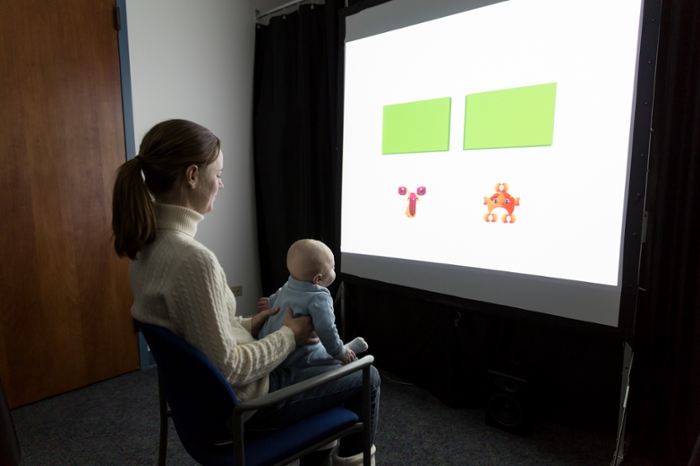Abstract Rule Learning in Human Infants
Study is first to show that 3-month-olds can learn abstract rules
Get all our news

By showing babies patterns of images on a screen, IPR's Sandra Waxman discovers that babies are able to abstract rules in the visual domain.
Three-month-old babies cannot sit up or roll over, yet they are already capable of learning patterns from simply looking at the world around them, according to a recent Northwestern University study published in PLOS One.
Throughout the animal kingdom, being able to detect not only objects and events, but also the relations among them, is key to survival. Among humans, this capacity is exceptionally abstract. When we learn a rule or pattern in one domain, such as an alternating pattern of lights, we readily abstract this pattern and apply it to another domain—for example, an alternating pattern of sounds.
This ability, known as “abstract rule learning,” is a signature of human perception and cognition. What we do not know is how early it develops.
Prior research documented that 4-month-old infants successfully abstract rules from speech sounds and tone sequences, but failed to abstract rules in the visual domain, such as from patterns of objects. This presented a puzzle: Why were infants’ successful at detecting abstract patterns from the sounds that they heard, but not from the objects they saw?

New research from IPR developmental psychologist Sandra Waxman and her Northwestern colleagues, Brock Ferguson (PhD ‘16) and Steven Franconeri, solves this apparent puzzle. For the first time, the researchers show that 3- and 4-month-old infants can successfully detect visual patterns and generalize them to new sequences.
“If you present infants with the stimuli in a more appropriate way for the visual system, they can learn abstract rules visually, just as they can from speech,” Ferguson said.
The researchers showed 40 infants patterned sequences of different kinds of dogs. For example, infants learning an “ABA” pattern might see a picture of an Alaskan malamute (A) followed by a picture of a German shepherd (B), and finally another Alaskan malamute (A). Infants saw several “ABA” sequences, each time with different kinds of dogs.
Then, the researchers presented infants with two new sequences with new kinds of dogs that the infants had not yet seen. The elements in each sequence were identical—only the pattern in which they were presented differed. One sequence followed the same ABA pattern (terrier, setter, terrier); the other followed a new AAB pattern (terrier, terrier, setter). Measuring how long the infants looked at each of these two sequences allowed the researchers to gauge their attention.
Although the elements in the AAB and ABA sequences were identical, infants noticed the different patterns. This documents infants’ ability to learn abstract rules visually.
The infants’ success in this experiment reflects something key about the visual system, Waxman explained. Unlike all prior experiments, infants in this study could see all three images together on the screen. The researchers note that the auditory system most effectively abstracts patterns from sequences that unfold over time (like listening to language or music), while the visual system is better at extracting patterns from sequences that are structured in space.
“Auditory learning is able to get patterns like ABB or ABA, just by hearing them in a sequence,” Waxman explained. “The visual system needs to take a moment to see all the things together.”
The study results indicate that infants are learning such abstract rules through seeing from a very early age.
“The basic capacity of abstract rule learning has its origins in infancy,” Waxman said. “Babies are doing really powerful abstraction from just their observation of the world.”
Sandra Waxman is the Louis W. Menk Professor of Psychology and an IPR fellow.
Published: February 28, 2018.


